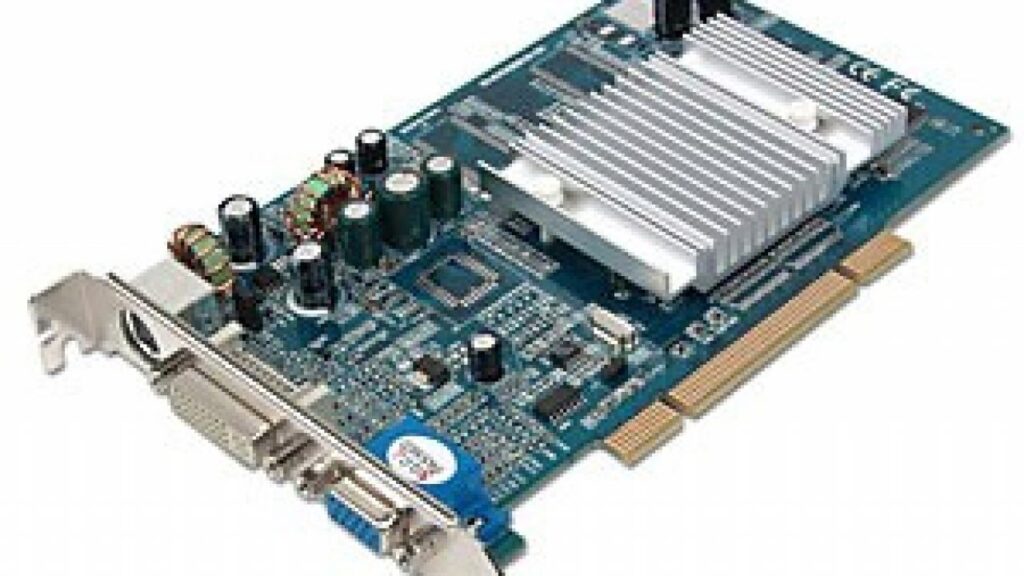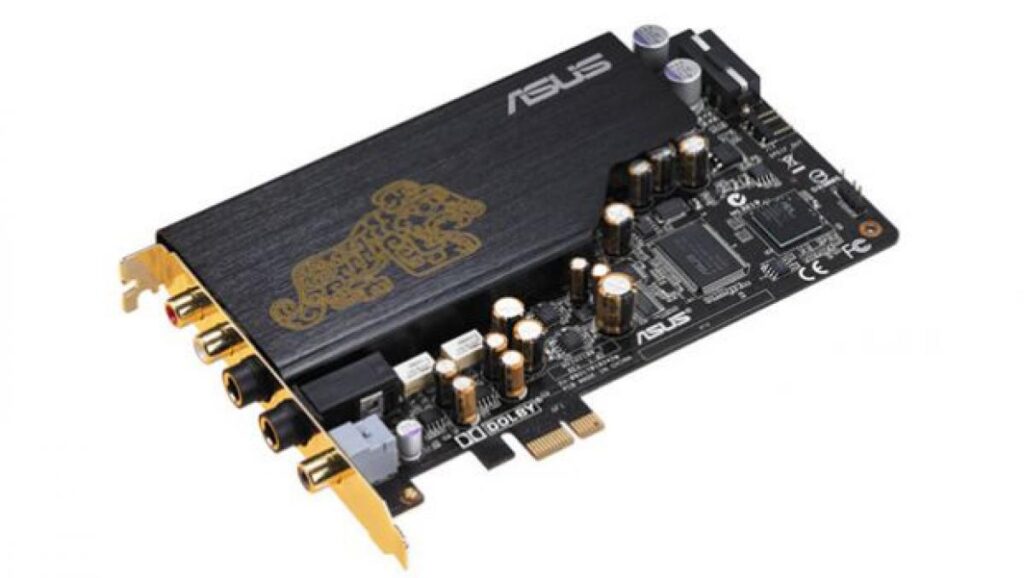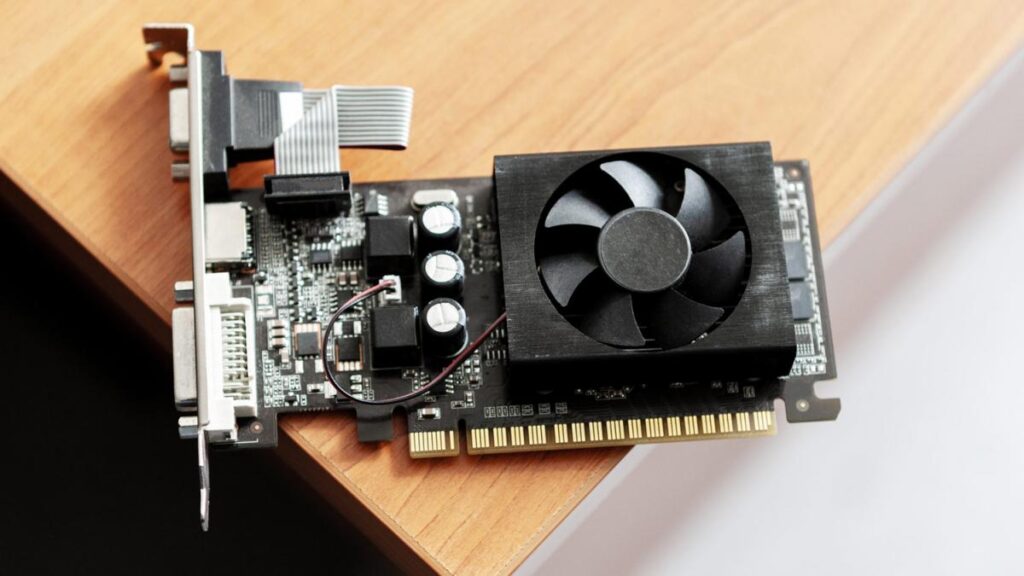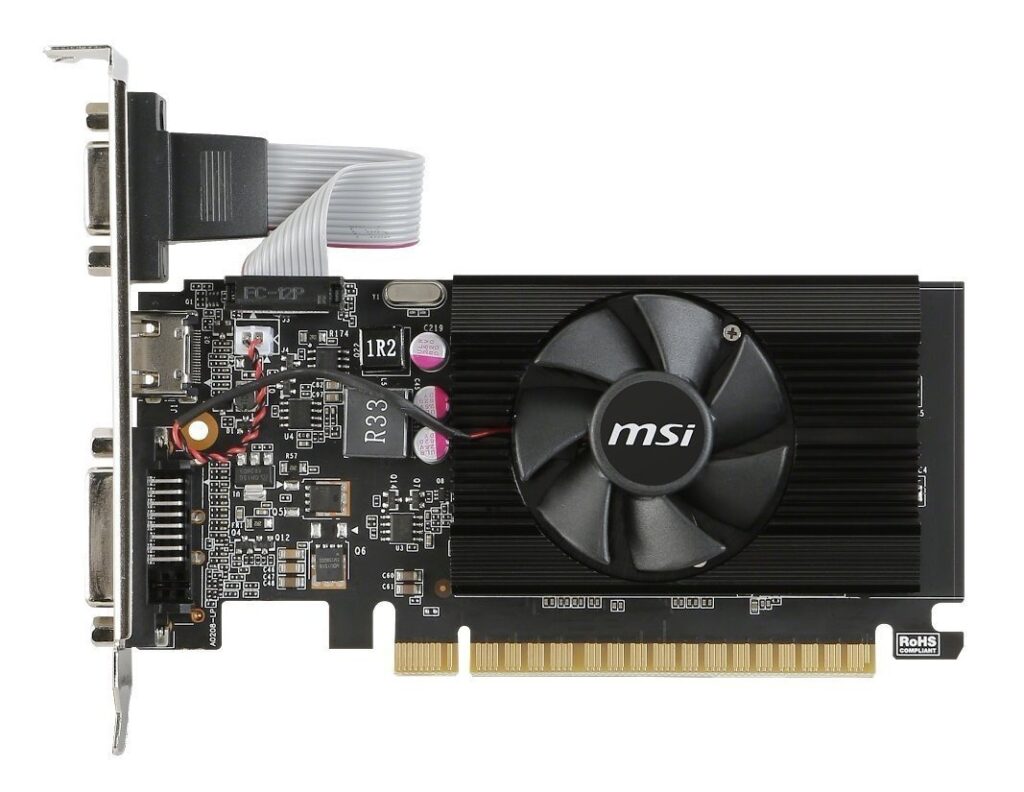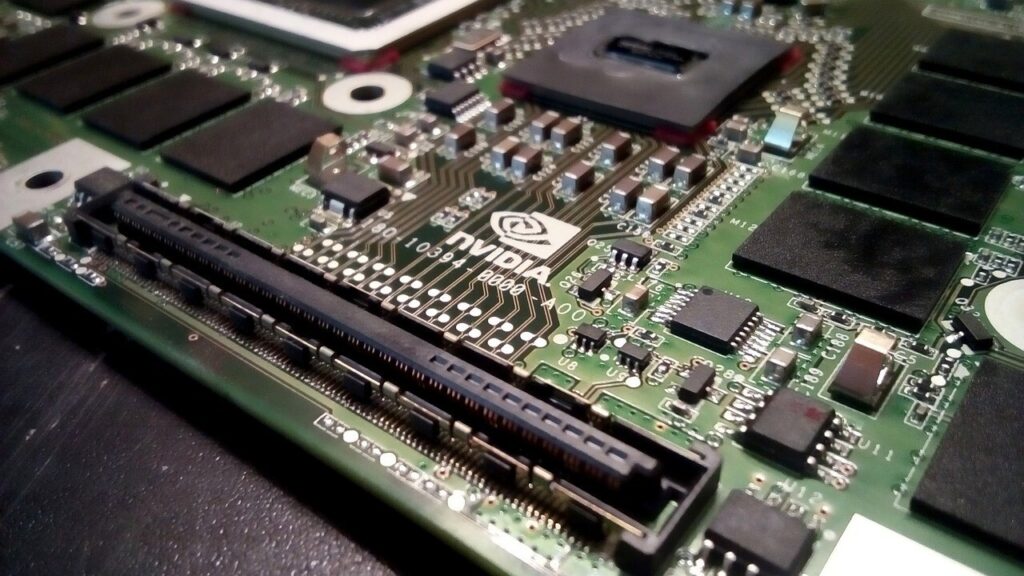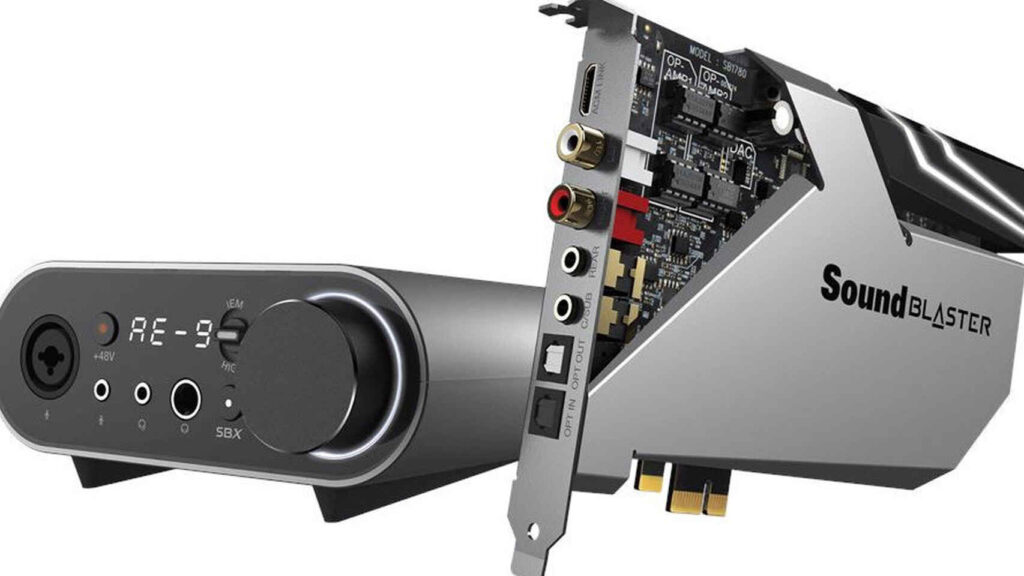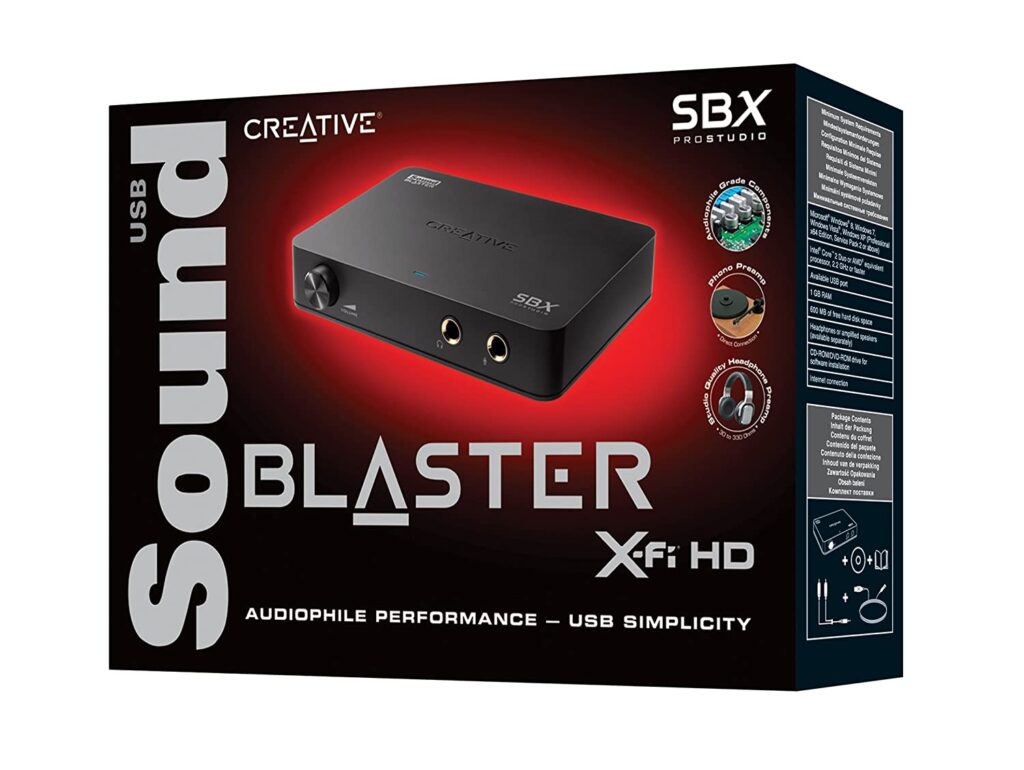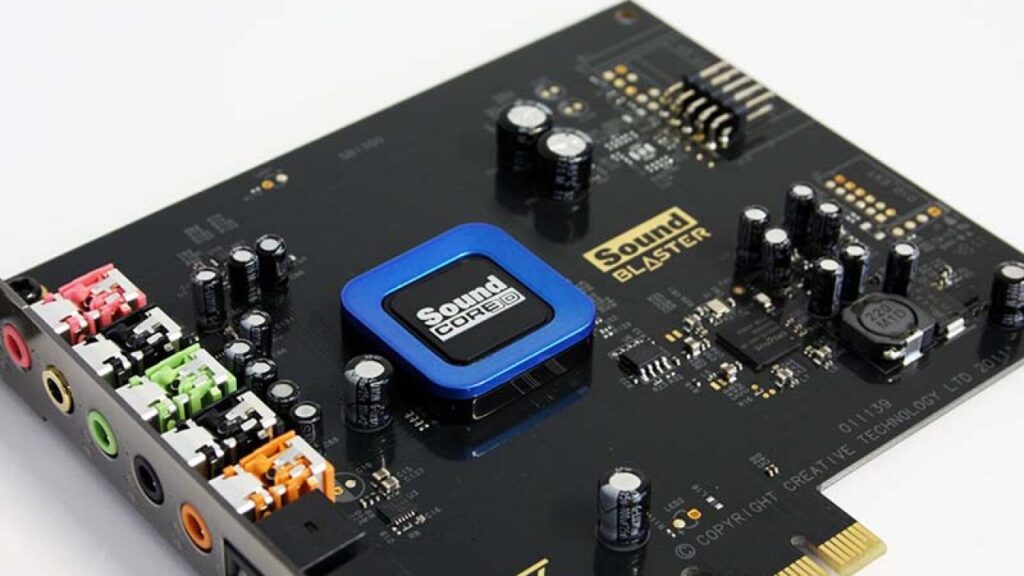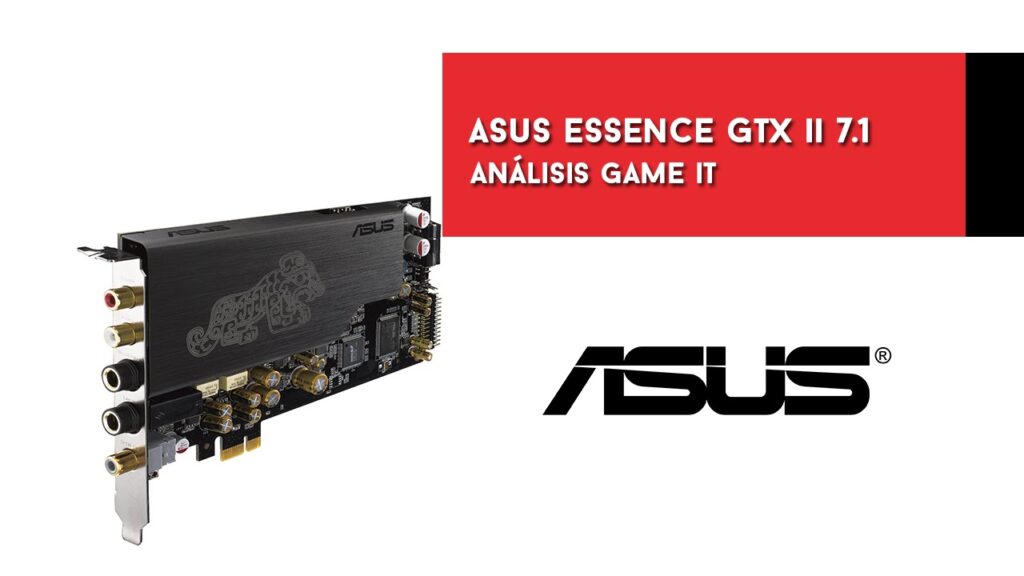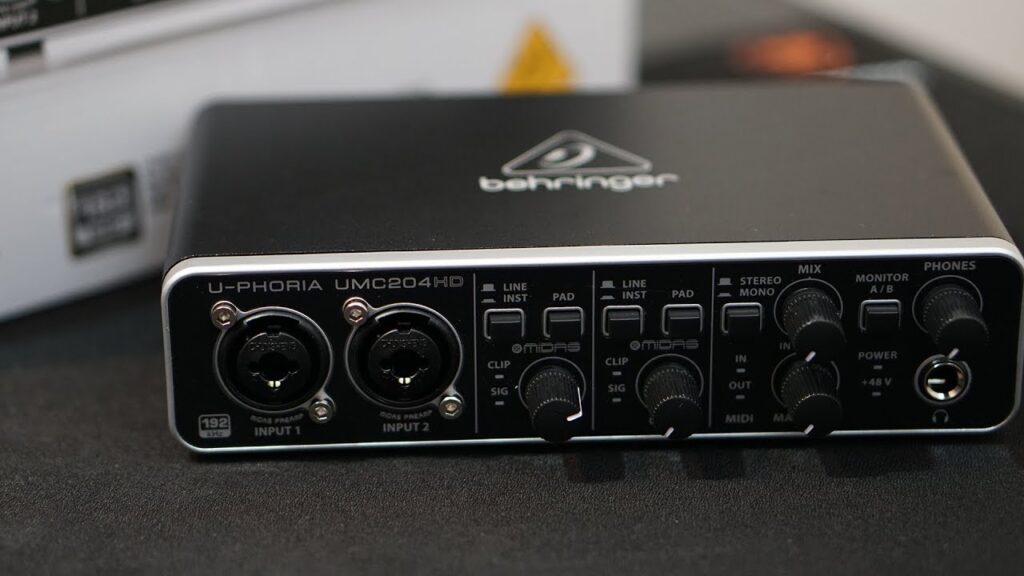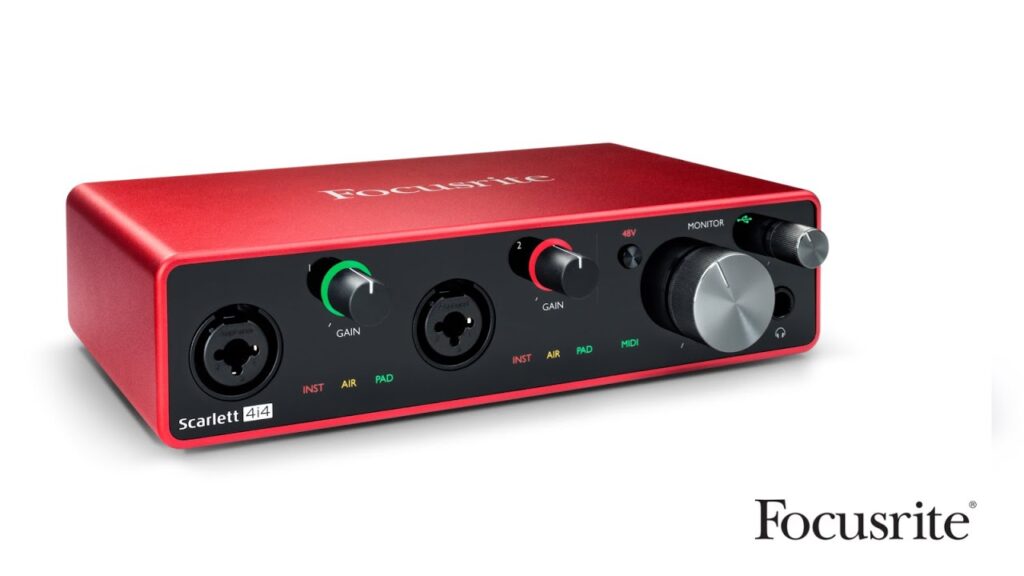One of the devices that are part of a computer is the card de . Its main function is to deal with all the voice elements. This is usually already included on the motherboard of the computer. However, it can be changed in order to optimize the functions of the pc. That is why in this post we will provide you with all the necessary information about this component of your computer, taking into account aspects such as: what it is, what it is for and even the types that exist (external and internal), and much more. .
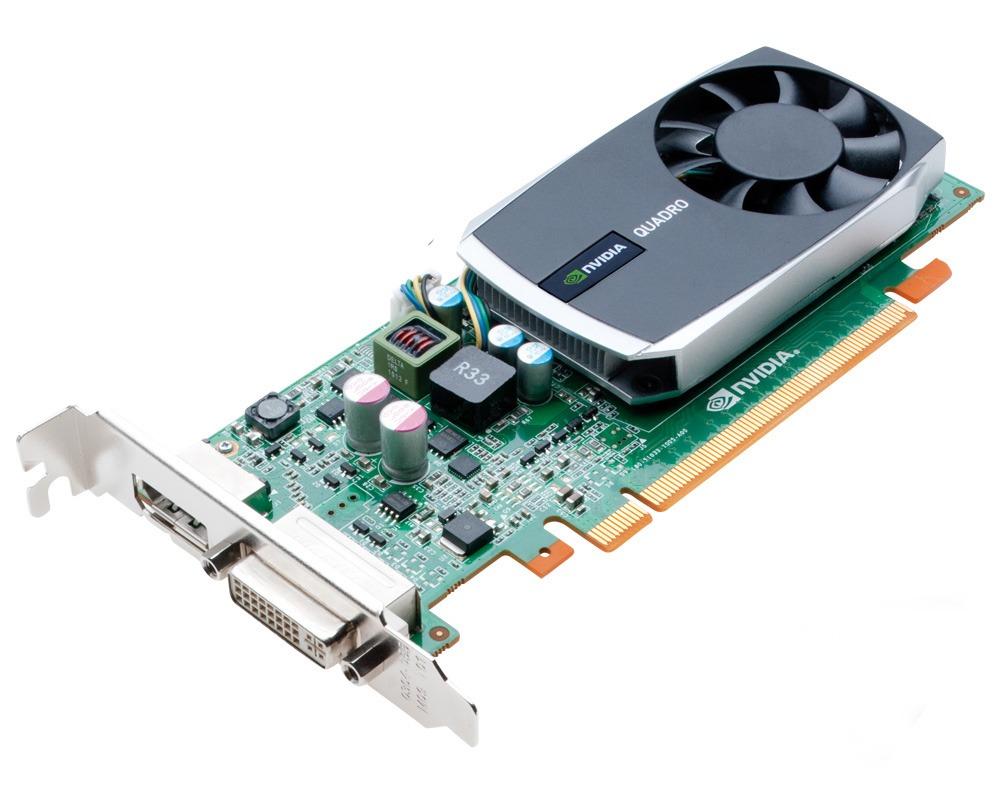
Sound card
Una card de It is an expansion board that allows a PC to send information related to audio to a sound device, be it speakers, headphones or others. All this through the control exercised by a computer program called controller or drivers.
It is necessary to mention that unlike the CPU and RAM, the card de , it is not an essential component for the computer to work properly, although it is worth having, since it deals with the input or output of the elements related to sounds in the computer, such as voice and music .
There are many sound cards that can be obtained on the market, it is essential to know them in order to know which one is best for you to install on your computer. So if you need to place one or want to change the one you already have, you need to know that you have different options to choose from.
Likewise, it is important to know some fundamental aspects about sound cards such as their description, the relationship with audio quality, and others. Learn about these features below.
Description
The sound card is a piece of hardware, it is rectangular in shape and has multiple contacts at the bottom, as well as port numbers on the side, they are located there to connect different audio devices, such as speakers or speakers. .
It is necessary to mention that the sound card must be installed in a PCI or PCIe slot, inside the motherboard, since both the motherboard and the case and peripheral cards are designed based on compatibility, therefore the sound card It should fit into the back of the PC drawer so that its ports are available for constant use.
On the other hand, there are many sound cards that allow the connection of headphones, microphones and other audio devices through an adapter that can be connected directly from any USB port.
Then we invite you to watch the following video, in which you will learn in detail some aspects that define a sound card:
Sound Cards and Audio Quality
Modern computers do not have expandable sound cards, on the contrary they have this expansion technology installed directly on the motherboard. It should be noted that this type of configuration allows the computer to slightly optimize the audio system. On the other hand, computers with this technology are a little cheaper. They are ideal for those who use a PC on a personal level.
Now, as for the external sound card It is intended for those individuals who want to get professional audio. It should be noted that in general, the computer cases have been designed with front USB ports, in addition to some port for headphones and microphones on the front. It is necessary to mention that these share a ground wire, which sometimes generates interference.
To avoid interference, it is advisable to avoid the use of USB ports, or it is also preferable to use the sound ports offered by the sound cards on the back of the computer case.
My computer has no sound
There are several reasons why a computer does not have sound, one of them is that the card or even the speakers have been disconnected from the respective ports, for this reason it is recommended to view the port and verify the connection.
Also, it is necessary to take into consideration that sometimes the volume of a video, song or movie that is being played can be quite low or even muted. In this case it is recommended to check the sound of the PC system.
Although it can also happen that the computer has no sound because the sound card is disabled in the device manager of the computer. Or that it does not deliver the proper sound, in which case it is necessary to update the device driver.
In order to solve these possible causes, the individual is advised to check out the various free tools that are helpful in updating sound drivers in Windows or other operating systems. If the problems persist, then it may be that the computer does not have the appropriate software, for this reason it is advisable to check the audio programs that allow you to play files with different formats or even convert them into conventional formats.
Find Out More
Most individuals are aware of how speakers work in a computer, that they must be connected to the back of the computer in order to get the necessary control of all the sound produced by the PC.
However, it should be considered that not all ports are for audio output, since currently sound cards include some port for all types of users, so these are intended for the connection of microphones, joystick, in addition to auxiliary devices.
It is worth noting that some ports are identified with a label so that the user can easily identify the port and the function that it fulfills within the video card, such is the case of those special cards for editing professionals. audio.
History
The history of sound cards begins in 1987, when the first one was created, it was compatible with computers. This was named after the company that manufactured it Adlib and its founder was Martin Prevel. After creating the first sound card, Prevel intended to promote it at IBM, however, the businessman had no experience in the industry, which is why he had various difficulties in placing his product.
Some time later, he did business with the president of the Top Star company, who was pleased with the demonstration of the card's functions. So, he was encouraged to participate in the promotion of the product. After the appearance of the original card, there were many entrepreneurs who optimized the product until it included the function of recording and reproducing digital audio.
Sound Card: Parts
After knowing what is sound card, It is essential to know the parts that make up this valuable component of the computer.
- Interface with the motherboard, its main function is to be a transmission medium between the computer and the sound card.
- Buffer, this temporarily stores the data that is transferred between the PC and the card. With the purpose of avoiding mismatches in the transmission speed of each data.
- ADC, stand for the term analog digital converter. This has the function of transforming analog sound signals into digital, through three sampling, quantification and encoding, in order to achieve a binary sequence that represents the voltage at a given time.
- DSP, identifies the digital signal processor. Which is a microprocessor with the ability to perform calculations and treatments on the sound signal, allowing the CPU not to do this job. It is worth mentioning that it is the sound card that does these tasks of understanding the recording and decompression by playing back a digital sound.
- DAC, Digital Analog Converter, this reconstructs an analog signal from the digital version, producing output voltage, depending on the values it receives.
- FM Synthesizer, is a frequency modulator, which forms complex waves to define the timbre, also interferes with the tone, volume, frequency and amplitude of the wave.
- Mixer, it is used to combine the inputs and take them to the outputs.
What is the sound card for?
The main function of a sound card is to allow the user to have the ability to enjoy different multimedia content, thus listening to the audio present in videos, movies, songs, video games. In addition to various applications that have educational and work aspects. Thanks to this card you can record sounds and facilitate communication.
The sound card has an importance to highlight, it allows remote meetings, in order to provide information through virtual classes. It also helps to optimize and enhance the sounds, since over time, these have acquired additional functions that considerably improve their performance.
Other Functions
In addition to the main function (which was described in the previous point), the sound card has other secondary functions, which have been added to it over time. These cards are responsible for providing the voices, and also the audio channels to the equipment.
It should be noted that these determine the number of simultaneous sounds that are played, as well as the number of outputs. The sound cards that were initially released on the market only had about nine voices and a single channel (mono audio), however, the current ones exceed that mark, and allow the configuration of the voices depending on their use.
Other functions of sound cards are related to improving sound in video games, this being one of the most powerful markets. An example of this is the well-known Bass Boost, which is found in some devices in order to strengthen heavier sounds or 5.1 and 7.1 virtualization when using headphones.
Also, sound cards have acquired more trivial functions, such as control of equipment elements, including fans and even RGB synchronized lighting. Everything will depend on who the card is addressed to.
Additional Information
Generally, when you buy a motherboard, it already has a sound chip as standard. Although its capabilities are limited, it can power PC speakers as part of basic computer sound. However, sound cards are purchased separately, among the most common three variants stand out:
- MP3 card.
- 24 bit card.
- And the surround sound card.
MP3 card
If you are one of the fans of the MP3 format, and of the hard drives with digital audio files, you will be able to realize the specialized sound cards. The MP3 card contains hardware that serves as an encoder and decoder, which speeds up the PC for ripping (the processor that creates MP3 files from digital audio CDs) and also for MP3 playback performance.
24 bit card
For the best audio reproduction, it is recommended to choose a 24-bit card, that is, those that have 192 KHz for the headset. This produces a sound superior to that produced by almost all audio CD players.
These cards also manage to support DVD audio, in addition to having the function of front panel controllers and having an integrated Firewire port.
Surround Sound Cards
These are specifically designed for ambient XNUMXD audio in video games and for full Dolby surround sound when enjoying a DVD movie on your computer. It is worth noting that more than two simple speakers are required in order to appreciate all the effects. That is why a pair of speakers is included on the cards.
Sound Cards: Aspects to Consider
Before making a list with the names and then the details of the most popular sound cards on the market, it is worth taking into consideration certain aspects, so that you can properly choose a card of this type when time to upgrade the one you own or when you want to buy a new computer.
- SPDIF (Sony-Philips Digital Interface) output, which allows output to a digital amplifier using a coaxial (RCA) cable.
- MIDI interface is the communication interface standard which allows multiple electronic musical instruments to work together. It fulfills the function of conducting the sound of the synthesizer in the computer with an external keyboard. It is recommended to consider this aspect if you are a musician, since this would be the ideal card for you.
- Microphone input, allows the input of one of these devices to a computer, it is particularly useful for VoIP.
- Resolution, an important aspect to consider, since it regulates the quality of the sound. These resolutions are expressed in bits. It's worth noting that the best sound cards today offer both 16-bit and 24-bit resolution, the higher the resolution the better the sound.
- Sampling refers to the frequency, which is defined in hertz. The higher the frequency, the better and higher the quality.
More
Another aspect to consider is the type of connection, since sound cards have various options when it comes to being connected to editing devices. Get to know these alternatives one by one.
- USB 2.0 is the most efficient in a home environment, with a capacity of up to 16 simultaneous inputs and outputs of audio channels.
- USB 3.0 is far superior to 2.0, however it generates a capacity that is wasted in a domestic environment. If you require a sound card for a recording studio or for advanced work, this would be the ideal one.
- Firmware, it is currently a feat to have a firewall on motherboards or laptops. The USB has positioned itself strongly in the industry, replacing this type of port. Although it should be taken into account that depending on the equipment, it can still be found.
- PCI-E is based on a fast serial communication system, it uses the concepts of programming and current information standards, the most used being Intel.
- PCI-X, is the next version of PCI-E, it has a frequency of up to 32 times faster. Unfortunately, if you add more than one device, the base frequency drops and you lose some of the transmission speed.
- Thunder Bolt is a type of connector that uses high-speed optical technology. Currently the third version is already available, which offers one of the fastest connections.
Internal Sound Card
Let's remember that the sound card is a device that connects to the motherboard of a computer or that can be integrated into it. It plays music and any audio signal. The internal ones are developed to occupy an internal PCIe slot of the equipment, therefore, they should be used in desktop PCs or in expansion boxes.
The most popular internal sound cards on the market are:
- Sound Blaster AE-5 Plus with 3 channel 5.1 outputs, and connections to headphones, speakers, lines, microphone, TOSLINK optical output.
- Sound Blaster AE-7, with 3 5.1 channel outputs, and connections to headphones, speakers, lines, microphone, TOSLINK optical output.
- The Sound Blaster AE-9, with channel and ACM link output, and connections to center and rear 3,5mm, RCA and 2 optical TOSLINK outputs.
- Creative Sound Blaster Z, with 5.1 channel output and connections to headphones, speakers, lines, microphone, optical TOSLINK input and output.
- Creative Sound Blaster Audigy with 5.1 channel output and separate microphone and line in/out connectors.
- Asus Xonar DG, with 5.1 channel output, plus three line outputs, 1 line input and 1 optical digital output.
- Asus Essence STX II, with 7.1 channel output, and 6.3 mm Jack, 8 RCA headphone output connections. 3mm Jack combo line inputs, digital microphones, an S/PDIF output, and a front panel header.
It should be noted that all of these are compatible with the Windows operating system and have a PCI-e 3.0×1 format.
Sound Blaster AE-5 Plus
It is a PCI-e SABER 32 Ultra-Class 32-bit/384 KHz high-resolution dedicated gaming internal sound card and DAC with Dolby Digital and DTS, up to 122 dB SNR, with RGB lighting system.
Features
The main features of the Sound Blaster AE-5 Plus card are
- Support for Dolby Digital Live and DTS encoding to expand output options to external audio devices. In addition, the AE-5 Plus card supports discrete 5.1 and virtual 7.1 surround sound, in addition to Sound Blaster's surround sound virtualization technology.
- Powerful custom-designed discrete headphone amplifier that uses bi-amping technology to power each headphone individually.
- Clear audio quality with PCI-2 SABER 32 ultra-Class DAC, which offers 32-bit / 384 KHz playback, allowing for ultra-low distortion and jitter. The audio from this card is perfect for games, music, and movies. It also provides crystal clear clarity and superior performance.
- It has customizable RGB LEDs on the housing. With up to lights and sounds with 16.8 million colors in different patterns. All through Sound Blaster Command software for pc.
- This card's interface provides hardware-processed sound enhancements as well as complete control of audio output via the Sound Blaster Acoustic Engine.
Data
This is the most recent card that the manufacturer has released. It is worth noting that it offers the best for games and creations, thanks to its SABER-Class DAC that supports 32-bit / 384 kHz audio, in addition to its Sound Core 3D audio processor.
Likewise, the Sound Blaster AE-5 Plus sound card is optimized for use with a professional headset, since it has a Xamp headphone bi-amplification system. For more information, we invite you to access the following link.
Sound Blaster AE-7
The internal sound card Sound Blaster AE-7 – Hi Res PCI-E and AMP Sound Card with audio control module and independent headphone bi-amplifier Xamp is characterized by:
- Features Hi-Res Audio – Reference ess SABER-Class 9018 DAC with 127Db DNR, plus 32-bit and dsd playback, -120dB (0.0001%) total harmonic distortion.
- Surround Surround Sound – The Sound Blaster AE-7 supports discrete 5.1 channels for speakers and up to 7.1 virtual sound for headphones.
- Pristine audio, a discreetly designed, patented bi-amplifier in the headphones with a strip to amplify each audio channel independently for crystal clear sound.
- It has virtualization technology, which can be completely customized taking into account the needs of the individual.
Other data
The Sound Blaster AE-7 internal sound card model is similar to the AE-5. These differ in that the AE-7 includes an advanced sound control module and is geared towards gamers. Like the AE-5, this one also features Dolby Digital and DTS compatibility.
Sound Blaster AE-9
It is a high-end sound card that has a high-resolution ESS-SABER class 9038 core with ultra-high DNR of 129 dB. It also features 32-bit / 384 kHz playback via PCM, DSD 64, and -120 low harmonic distortion.
Other features include Clean Line technology, which filters and isolates the noise that may be generated by the microphones. In addition, it has a double Xamp amplifier for headphones. Also, Dolby Digital Live and DTS Connect Encoding.
It also features a TOSLINK optical input and output, as well as a 3,5mm rear output. A 3,5mm center out and ACM Link. In addition to a power connector that has 6 pins, (it should be noted that this is necessary for ACM) and two front RCA outputs.
This card is one of the most features currently available. It has the best components among them the ESS SABER-Class 9038 high resolution DAC, which supports 129 dB DNR and 32 bits / 384 kHz. It also has an external audio control, it goes one step ahead of the AE-7 model, since it is compatible with dynamic or condenser microphones with phantom power.
It should be noted that the rear panel of the Sound Blaster AE-9 sound card has two optical outputs, in addition to 2 x 3,5 jacks, as well as RCA outputs and an ACM link.
Creative Sound Blaster Z
It is an internal sound card that has a Sound Blaster microphone included. It features SBX Pro Studio technology and Crystal Voice optimized and with more clarity. Plus, it features pristine audio recordings with low latency and a 116dB signal-to-noise ratio.
Another feature that stands out in this card is the Sound Blaster Z series control panel. To install it, it is required that the system has the following requirements:
- It is recommended that Intel Core Duo or AMD processor or equivalent 2.2 GHz or higher.
- An Intel, AMD or 100% compatible motherboard with Windows 10, 7 or 8 32/64-bit operating system.
- 1 GB RAM, >600 MB available hard disk space.
- One PCI Express slot (x1, x4, or x16) available.
- An available CD-ROM or DVD-ROM drive.
This card version is cheaper than the versions detailed above, while still providing almost the same specifications. The biggest difference between this and the previous ones is that the Sound Blaster Z sacrifices the external controller and in order to have 5.1 surround sound it is necessary to be connected to the decoder or home theater system.
The Creative Sound Blaster Z card is a great option if you don't have a 5.1 speaker setup to take advantage of, however it is ideal for crystal clear sound quality.
Creative Sound Blaster Audigy FX 5.1
It is an internal sound card that has SBX Pro Studio and cinematic 5.1 sound. It includes a Sound Blaster Audigy FX control panel, for control of SBX Pro Studio settings. It also incorporates a 192 kHz digital-to-analog converter (DAC) in 24-bit playback.
It features a 106 dB signal-to-noise ratio (SNR) and a 600-Ohm headphone amplifier. In addition to independent line and microphone input connectors, which allow the connection of two different audio sources to the computer.
This card offers 5.1 sound and the cost of it is less than half of a Sound Blaster Z. Its digital to analog converter allows you to listen to music without processing. However, the number of connections is few and the signal/noise ratio is lower.
At first glance, this design is less attractive than the previous ones, but even what you are looking for is not a good and cheap sound card, then this is the ideal one for you.
Asus Xonar DG
It offers similar benefits to the Audigy FX 5.1 sound card. Both process surround sound, but they differ in that the Asus Xonar has a greater number of connection channels. Plus a slightly improved signal-to-noise ratio.
As far as the frequency range is concerned, the Asus Xonar DG has an amplitude of 10Hz-87Hz, which makes it superior to the 20-20kHz of the Audigy FX. Its PCI-E channels are
- 24 bits
- 116 dB
- 100 dB
- 24-bit / 192kHz
- 00251%
Asus Essence STXII
It is a high-end model of internal sound card, it doubles the price of the Creative Sound Blaster ZX. This supports up to twelve connections, as well as a frequency range of 10 Hz-90 kHz and its compatibility is so remote that it reaches the times of Windows XP.
In general, it is a fairly expensive card, motivated by the 7.1 surround sound with 120 dB of SNR that it has, through a daughter board that is included in the package. This is one of the best internal cards for computers.
External Sound Card
Like sound interfaces, external cards are specified via USB, and transmit the information that has already been processed to the computer. As opposed to internal ones that plug directly into a computer motherboard. The models of these cards are more noticeable in users who perform recording work or related to music editing. Learn about the most popular on the market below, and later the details and specifications of each of them.
- Focusrite Scarlett 4i4, with signal to noise ratio of 96, the channel output of 2.0. Its connection is with a MIDI input and output, four analog outputs and digital converters. It has compatibility with Mac OS X Yosemite and Windows 7 onwards.
- Behringer UMC 204 HD, with 96.3 dB signal-to-noise ratio, 2.0 channel output Its connection is with two XLR combos, 6.3 mm Jack outputs (A) and 2 RCA outputs (A and B9, plus input and output MIDI It is compatible with Mac Os X and Windows XP onwards.
Other External Cards
- Behringer UM2, with signal to noise ratio of 0 dB, the channel output of 2.0. Its connection is with two inputs and two outputs, in addition to a combo XLR / Jack 6.3 mm input. It has compatibility with Mac Os 10 and Windows XP onwards.
- Audient ID 14, with signal to noise ratio of 96 dB, the channel output of 2.0. Its connection is with ADAT input or channels, it allows to expand up to a total of 10. It has compatibility with Mac Os 10.07 and Windows 7 onwards.
- Steinberg UR 242, with signal to noise ratio of 0 dB, the channel output of 2.0. Its connection is with 2 analog inputs, an XLR combo, two line outputs and a headphone output. It has compatibility with Mac Os 10.07 and Windows 7 onwards. Its measurements are 240 x 210 x 100.
Behringer UM2
It is an external sound card that is characterized by having a 16-bit / 48 kHz USB audio interface. Also two inputs and two outputs. Also a 6.3 mm XLR/Jack combo input. It also has a microphone preamplifier, which has been designed by Xenyx Thomann, it has 48V Phantom power.
This card has a Hi-Z input and a clip and signal indicator, as well as direct monitoring. Its use is practically for day to day. The connection of the Behringer UM2 is via USB 2.0 and it has a 2.0 stereo channel output. Its measurements are 128 x 118 x 50.
It is not a well-known card nor is it the most popular of all, but it allows you to mix two input channels, without the need to use a computer. It should be noted that the possibilities for self-production for amateurs are present in the Behringer UM2, for this reason, it is considered quite competent within its price range.
Behringer UMC 204HD
This external sound card has a USB audio / MIDI interface. With 24 bits and 192 kHz. Likewise, it has two inputs and four outputs, in addition to 2 XLR / 6.3 mm jack combo inputs. It also features MIDAS-designed mic preamps and includes 4-8V phantom power.
The Behringer UMC 204 HD steps up a notch from the previous model (Behringer UM2). The chassis of it happens to be metal and not plastic. Another feature is that it increases the number of connections.
It connects via USB 2.0, which is quite common for external cards. A PAD button is included on this model in addition to the MIDI input, offering more features in addition to the mic preamps. Its measurements are 185 x 130 x 50.
Steinberg UR 242
The Steinberg UR 242 mkII 2.0 channel USB, is a sound card characterized by 2.0 channels, 24 bits, USB connection and availability for Windows 10, Mac OS X 10.10 Yosemite, Mac OS X 10.11 El Capitan, Mac OS X 10.7 Lion and Mac Os X 10.8 Mountain.
It is a 24-bit / 192 kHz USB 2.0 audio interface. MIDI in and out. A fairly robust card with a metal case, which has a Loopback function for Internet Live Broadcasting. This contains Cubase AI music software, as a download version for Mac and for PC. As well as the Cubasis App for iOS. It is compatible with Windows, OS X and iPad (with the Apple iPad Camera Connection Kit / Lightning to USB Camera Adapter.
It also has 2 Class D preamps to mic preamps with phantom power over 48V. It also has two analog XLR combo inputs (Hi Z to input 2), as well as two line outputs (balanced jack) and a headphone output with individual regulation.
Another aspect of this card is that it has Industrial Bar also on the iPad thanks to CC mode and USB Micro Connector, for a fully powered USB external power on Mac and PC.
Find Out More
This external sound card does not require a power supply, other than the USB 2.0 connection to the computer itself. It has a steel chassis and a frequency range between 20 Hz-20k Hz, and also presents a practical format for studios and sound checks in venues.
In addition, among its features you can add its compatibility with operating systems such as Mac and Windows. Although it can also be connected to iOS systems for Apple iPad and iPhone. Finally, one last aspect of interest must be considered, which refers to its Loopback function for streaming retransmissions, mixing the input audio signals with the playback signal coming from Cubase or another DAW.
Focusrite Scarlett 4i4
It is an external audio card that is characterized by the aspects described below
- It has two microphone preamplifiers with the best performance ever in the range of Scarlett cards. It also now features a selectable air function to give recordings a brighter, more open sound.
- It features two high dynamic range instrument inputs for connecting guitars or basses.
- It also has two balanced line inputs for connecting synths, drum machines, and other line-level sources.
- This card has four balanced outputs, the same with the purpose of obtaining a clean monitoring and to avoid audio effects pedals.
- Another feature of this card refers to its high-performance converters, characterized by allowing the user to mix and record up to 24 bits / 192 kHz.
Find Out More
The Focusrite Scarlett 4i4 is an external sound card that connects to your computer via USB Type-C and features a frequency response of 20Hz – 20kHz. Despite having a fairly standard amplitude, the sound you get is natural enough. In addition, the card itself offers programs that facilitate editing, among them the Focusrite Creative Pack, Ableton Live Lite and Pro Tools.
This card is portable, it has been designed for Home Studio environments, in order to facilitate the calibration and recording of music with good quality, even if it is not in a professional way.
Another card belonging to the same manufacturer (Scarlett), is the 2i2 Studio 3rd Gen, which has two high dynamic range instrument inputs to connect guitars or basses, it has an Easy Start tool. Its measurements are 47 x 210 x 138.
Audience ID 14
The Audient ID 14 card is characterized by having two class A console microphone amplifiers. It also has an independent headphone amplifier output stage, and console monitor control with: mono, polarity, cut, talk and audio mix. indicators.
Additionally, the card has 2 combo jacks intended for mic/line inputs. Also, the 8-channel ADAT input supports expansion up to 10 channels. This requires a larger budget, motivated by the large number of connections and functionalities it has. The same ones related to size, since it is quite small considering its measurements, which are 15 x 12 x 4,5.
The Audient ID 14 has a total of eight output connections, which can be expanded to 10. It also has four input connections. Its structure is made of steel, and it is not only limited to the chassis, but also has buttons on the cover. Its connection port is USB 2.0 to PC and it reaches a frequency of 20 Hz to 22 kHz.
Conclusion
Sound cards are part of an industry that has a reliable correlation between product quality and price. This particular part of the electronics 100% demonstrates the saying that "quality has to be paid for"
We recommend that all readers acquire an internal card in case the use that is going to be given is a home cinema or as a music system, both in a specific room. Now, if on the contrary, you have a small recording studio or you are a fan of playing instruments, or you like to sing live in venues. Then, the most advisable thing is that you acquire an external sound card that has integrated controls and that offers you a fairly large number of connections.
At the end of the reading, you already have knowledge about what a sound card is. Also, the types that exist (internal and external), in addition to the most popular models on the market. For this reason we recommend you access the following links of interest, which are related to the subject of technology, computers and some of the devices that comprise it.
How do I know if my PC has a graphics card? and your type?
Know What games does my PC run or support? Step by Step.
How does Know the Model of my Mother Card?
